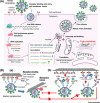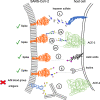Glycosylation is a key in SARS-CoV-2 infection
- PMID: 34023935
- PMCID: PMC8140746
- DOI: 10.1007/s00109-021-02092-0
Glycosylation is a key in SARS-CoV-2 infection
Abstract
SARS-CoV-2 causes the respiratory syndrome COVID-19 and is responsible for the current pandemic. The S protein of SARS-CoV-2-mediating virus binding to target cells and subsequent viral uptake is extensively glycosylated. Here we focus on how glycosylation of both SARS-CoV-2 and target cells crucially impacts SARS-CoV-2 infection at different levels: (1) virus binding and entry to host cells, with glycosaminoglycans of host cells acting as a necessary co-factor for SARS-CoV-2 infection by interacting with the receptor-binding domain of the SARS-CoV-2 spike glycoprotein, (2) innate and adaptive immune response where glycosylation plays both a protective role and contributes to immune evasion by masking of viral polypeptide epitopes and may add to the cytokine cascade via non-fucosylated IgG, and (3) therapy and vaccination where a monoclonal antibody-neutralizing SARS-CoV-2 was shown to interact also with a distinct glycan epitope on the SARS-CoV-2 spike protein. These evidences highlight the importance of ensuring that glycans are considered when tackling this disease, particularly in the development of vaccines, therapeutic strategies and serological testing.
Keywords: Blood group antigen; COVID-19; Glycosylation; Infection; SARS-CoV-2; Spike protein.
© 2021. The Author(s).
Conflict of interest statement
The authors declare no competing interests.
Figures





Similar articles
-
Human Basigin (CD147) Does Not Directly Interact with SARS-CoV-2 Spike Glycoprotein.mSphere. 2021 Aug 25;6(4):e0064721. doi: 10.1128/mSphere.00647-21. Epub 2021 Aug 11. mSphere. 2021. PMID: 34378982 Free PMC article.
-
Can SARS-CoV-2 Virus Use Multiple Receptors to Enter Host Cells?Int J Mol Sci. 2021 Jan 20;22(3):992. doi: 10.3390/ijms22030992. Int J Mol Sci. 2021. PMID: 33498183 Free PMC article. Review.
-
SARS-CoV-2 S glycoprotein binding to multiple host receptors enables cell entry and infection.Glycoconj J. 2021 Oct;38(5):611-623. doi: 10.1007/s10719-021-10021-z. Epub 2021 Sep 20. Glycoconj J. 2021. PMID: 34542788 Free PMC article. Review.
-
A Feasible Alternative Strategy Targeting Furin Disrupts SARS-CoV-2 Infection Cycle.Microbiol Spectr. 2022 Feb 23;10(1):e0236421. doi: 10.1128/spectrum.02364-21. Epub 2022 Feb 9. Microbiol Spectr. 2022. PMID: 35138160 Free PMC article.
-
Possible inhibition of GM-CSF production by SARS-CoV-2 spike-based vaccines.Mol Med. 2021 May 22;27(1):49. doi: 10.1186/s10020-021-00313-3. Mol Med. 2021. PMID: 34022793 Free PMC article.
Cited by
-
Variations in O-Glycosylation Patterns Influence Viral Pathogenicity, Infectivity, and Transmissibility in SARS-CoV-2 Variants.Biomolecules. 2023 Sep 29;13(10):1467. doi: 10.3390/biom13101467. Biomolecules. 2023. PMID: 37892149 Free PMC article.
-
SARS-CoV-2 Spike protein is not pro-inflammatory in human primary macrophages: endotoxin contamination and lack of protein glycosylation as possible confounders.Cell Biol Toxicol. 2022 Aug;38(4):667-678. doi: 10.1007/s10565-021-09693-y. Epub 2022 Jan 11. Cell Biol Toxicol. 2022. PMID: 35015170 Free PMC article.
-
Deglycosylation of eukaryotic-expressed flagellin restores adjuvanticity.NPJ Vaccines. 2023 Sep 26;8(1):139. doi: 10.1038/s41541-023-00738-3. NPJ Vaccines. 2023. PMID: 37752138 Free PMC article.
-
Replacing protruding domains of MrNV virus-like particles with sialic acid binding domains enhances binding to SARS-CoV-2 susceptible cells and reduces pseudovirus infection.Sci Rep. 2025 Jul 12;15(1):25200. doi: 10.1038/s41598-025-10792-7. Sci Rep. 2025. PMID: 40652081 Free PMC article.
-
The basis of mink susceptibility to SARS-CoV-2 infection.J Appl Genet. 2022 Sep;63(3):543-555. doi: 10.1007/s13353-022-00689-w. Epub 2022 Apr 9. J Appl Genet. 2022. PMID: 35396646 Free PMC article. Review.
References
Publication types
MeSH terms
Substances
LinkOut - more resources
Full Text Sources
Other Literature Sources
Medical
Molecular Biology Databases
Miscellaneous

